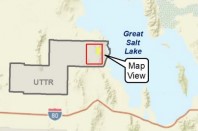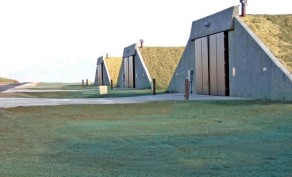Air Force gauges new ICBM force’s environmental impacts

Map supplied, U.S. Air Force
The red box on map shows the area where Air Force Minuteman III ICBM rocket motors will be destroyed as the Minuteman is decommissioned.
HILL AIR FORCE BASE — The Air Force has issued a draft environmental impact statement for its new ground-based intercontinental ballistic missile system, detailing potential effects of the system intended to replace the decades-old Minuteman III ICBM force.
Hill Air Force Base will play an outsized role in the planned Ground-Based Strategic Deterrent, dubbed Sentinel. Hill will continue in its role as the maintenance and testing headquarters for the Air Force’s ground-based ICBMs, coordinating and performing the decommissioning of the Cold War-era Minuteman missiles and assembling the Sentinel force’s rocket boosters.
The draft EIS, released last week, said the expected impacts of the program are considered to be less than significant in most respects, but significant cultural effects are anticipated in traditional tribal areas in the Wyoming, Nebraska, Montana and North Dakota missile fields. Some archaeological sites in Utah could also be influenced.
During the phased project, Minuteman III missiles will be taken out of silos arrayed over thousands of acres near F.E. Warren Air Force Base in Wyoming, Malmstrom Air Force Base, Montana, and Minot Air Force Base, North Dakota. The Sentinel missiles will be deployed in new silos in the same areas.
The project’s impacts are expected to be less than significant at the ICBM facilities at Hill and on the Utah Test and Training Range, according to the EIS. On the UTTR, decommissioned Minuteman ICBM rocket motors will be stored or destroyed over the planned eight-year decommissioning process.

Photo supplied, U.S. Air Force
A truck and trailer similar to what will be used to transport ICBM missile boosters to and from Hill Air Force Base.
Open burning of Minuteman III rocket motors will worsen air quality at UTTR, 50 miles west of Hill, during the decommissioning years, but the pollution will not exceed EPA limits in the Box Elder and Tooele county areas, the report said. All three stages, of up to 52 boosters, will be disposed of every year at UTTR. Their propellant will be burned off on disposal pads.
Air pollution will minimally increase at Hill, due to the expanded operation, and will not significantly worsen Davis County’s status as being in non-attainment of Environmental Protection Agency standards, according to the draft report.
Construction of the Sentinel system should begin in the mid-2020s and be completed by the mid-2030s, according to the Air Force Global Strike Command, based at Barksdale Air Force Base in Louisiana. As part of the program, new utility corridors are being proposed across the three sprawling missile fields. Excavation corridors are planned along 4,900 miles of existing Minuteman III silo easements.
At Hill, construction is already underway on a new Air Force Nuclear Weapons Center, the systems directorate of the Sentinel force. More than 700 people will work there. Construction is expected to be completed by mid 2023. Efforts to get more details about the construction work at Hill were not immediately successful.
The Sentinel boosters will be assembled at Hill where inspections, replacements, refurbishments, upgrades and testing of flight worthiness will occur.

Photo supplied, U.S. Air Force
An example of the type of ICBM storage igloos that will be built at Hill Air Force Base and the Utah Test and Training Range.
According to the draft study, Hill is the Air Force’s only location with the equipment, support services and trained personnel required to assemble, take apart and perform extensive maintenance on the boosters.
Once readied, an assembled booster will be loaded into special trucks and driven for installation in a silo. No ICBM warheads are handled or stored at Hill — the payloads are installed at the silos.
The environment study also looks at expansion of storage and other operations at UTTR. Eight rocket motor storage igloos will be built both at Hill and UTTR. The igloos are eight-bay, temperature-controlled, earth-covered magazines, each capable of storing 16 boosters. Construction of all facilities will take up to eight years.
At Hill, most employees currently working on Minuteman III maintenance will transition into Sentinel work. More than 275 employees will be added at Hill, but UTTR staffing will remain the same.
During the construction phases of the Sentinel program, an estimated $255.6 million will be spent and 535 jobs created.

Photo supplied, U.S. Air Force
Tech. Sgt. Joseph Lecureux, 741st Maintenance Squadron equipment NCO in charge, poses for a photo on Nov. 17, 2021, at Malmstrom Air Force Base, Montana. Lecureux manages 325 nuclear-handling maintenance items. The Air Force will scrap its Minuteman III nuclear missile force and replace it with the Sentinel missile, to be managed at Hill Air Force Base in Utah.
Once a Minuteman III motor is transported to UTTR, the propellant will be burned at one of the open-burn sites. The burning, two or three motors a week, will be tracked on a hazardous waste manifest. The expected emissions will be within existing permit restrictions, the EIS said.
Comments on the draft EIS may be submitted during virtual meetings Aug. 8-9 or in writing. Details are available at the EIS website.
- The red box on map shows the area where Air Force Minuteman III ICBM rocket motors will be destroyed as the Minuteman is decommissioned.
- A truck and trailer similar to what will be used to transport ICBM missile boosters to and from Hill Air Force Base.
- An example of the type of ICBM storage igloos that will be built at Hill Air Force Base and the Utah Test and Training Range.
- Tech. Sgt. Joseph Lecureux, 741st Maintenance Squadron equipment NCO in charge, poses for a photo on Nov. 17, 2021, at Malmstrom Air Force Base, Montana. Lecureux manages 325 nuclear-handling maintenance items. The Air Force will scrap its Minuteman III nuclear missile force and replace it with the Sentinel missile, to be managed at Hill Air Force Base in Utah.




